Harvard Bridge
The Harvard Bridge (also known locally as the MIT Bridge, the Massachusetts Avenue Bridge, and the "Mass. Ave." Bridge) is a steel haunched girder bridge carrying Massachusetts Avenue (Route 2A) over the Charles River and connecting Back Bay, Boston with Cambridge, Massachusetts. It is the longest bridge over the Charles River at 2,164.8 feet (387.72 sm; 659.82 m).[1]
Harvard Bridge | |
|---|---|
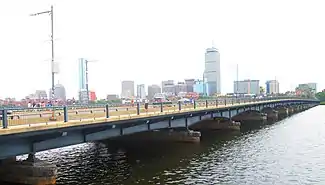 Seen from Cambridge (2017) | |
| Coordinates | 42.35457°N 71.09132°W |
| Carries | |
| Crosses | Charles River |
| Locale | Boston–Cambridge, Massachusetts, United States |
| Maintained by | MassDOT |
| ID number | B160124EYDOTNBI |
| Characteristics | |
| Design | Haunched girder bridge |
| Material | Steel |
| Total length | 2,164.8 ft (387.72 sm; 659.82 m)[1] (roadway) 364.4 smoots ± one ear (620 m) (sidewalk from Storrow Drive to Cambridge only) |
| Width | 69.3 ft (12.42 sm; 21.13 m) (total width)[1] 52 ft (9.3 sm; 15.8 m) (roadway)[2] |
| No. of spans | 25[3] |
| Piers in water | 24[3] |
| Load limit | 86.4 short tons (78.4 t)[2] |
| Clearance below | 12 ft (2.2 sm; 3.7 m)[2] |
| History | |
| Construction start | 1887 |
| Construction end | 1891 |
| Opened | September 1, 1891,[4] 1990 |
| Closed | 1983 (temporary closure for repairs) |
| Statistics | |
| Daily traffic | 49,000 as of 2005[2] |
| Location | |

| |
After years of infighting between the cities of Boston and Cambridge, the bridge was built jointly by the two cities between 1887 and 1891.[5] It was named for Harvard University founder John Harvard.[6] Originally equipped with a central swing span, it was revised several times over the years until its superstructure was completely replaced in the late 1980s due to unacceptable vibration and the collapse of a similar bridge.
The bridge is known locally for being marked off in the idiosyncratic unit of length called the smoot.[7][8]
Conception
In 1874 the Massachusetts Legislature authorized construction of a bridge between Boston and Cambridge,[9] and in 1882 follow-up legislation set out its location.[10]
The bridge was to have a draw with an opening of at least 38 feet (12 m; 6.8 sm).[10] Boston interests opposed the bridge, mainly because it did not provide for an overhead crossing of the Grand Junction Branch of the Boston and Albany Railroad. Further legislation in 1885 changed the draw to a clear opening of at least 36 feet (11 m; 6.4 sm) and no more, until the other bridges below the proposed location were required to have a larger opening.[11] There was still no substantive progress until 1887, when Cambridge petitioned the Legislature to compel Boston to proceed; the resulting act required each city pay half the cost, and allowed Boston to raise up to $250,000 (US$7,110,000 with inflation[12]) for this purpose, in excess of its debt limit. This implied an estimated cost of US$500,000 (US$14,200,000 with inflation[12]) for the bridge.
The Legislature provided for a bridge commission, to consist of the mayors of Boston and Cambridge plus a third commissioner to be appointed by the mayors.[13] The mayors of Boston and Cambridge, Hugh O'Brien and William E. Russell, appointed Leander Greeley of Cambridge as the third commissioner,[14] though this appointment changed over time.[15]
| Year(s) | Mayor of Boston | Mayor of Cambridge | Third Commissioner |
|---|---|---|---|
| 1887–1888 | Hugh O'Brien | William E. Russell | Leander Greeley |
| 1889–1890 | Thomas N. Hart | Henry H. Gilmore | |
| 1891 | Nathan Matthews, Jr. | Alpheus B. Alger | Leander Greeley (died February 15, 1891[16] or February 16, 1891[17]) George W. Gale |
The commission's 1892 report claimed:[16]
The effect that the bridge will have upon both cities is obvious. The low land and marshes on the Cambridge side, formerly almost valueless, have been filled in and have become valuable; and Cambridge is now connected with the choicest residential portions of Boston. The residents of the Back Bay, South End, Roxbury, and other southern sections of Boston are now connected directly, by way of West Chester park and the bridge, with Cambridge, Belmont, Arlington, and adjacent towns; and this thoroughfare in Boston, it is believed, will ultimately be the central one of the city.
Name
The bridge is named for the Reverend John Harvard, for whom Harvard University is also named, rather than for the university itself. Other names suggested included Blaxton, Chester, Shawmut, and Longfellow.[6][lower-alpha 1]
Engineering
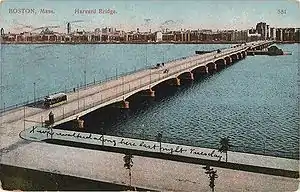

Originally projected as a wooden pile structure with stone pavement for the first 200 feet (61 m; 36 sm) (because the Charles River Embankment extension was expected to take that space) the design was changed to be entirely iron spans on stone piers. The general plans were approved on July 14, 1887.[18] The engineers were William Jackson (Boston City Engineer), John E. Cheney (assistant Boston City Engineer), Samuel E. Tinkham (assistant engineer), and Nathan S. Brock (assistant engineer at bridge).[19]
The subsurface conditions at the bridge location are extreme. Much of Boston is underlain with clay, but the situation at the bridge is exacerbated by a fault which roughly follows the path of the Charles River itself. From a depth of approximately 200 to 300 feet (60 to 90 m; 40 to 50 sm) below existing ground, is a very dense till composed of gravel and boulders with a silt-clay matrix. Above that to approximately 30 feet (9 m; 5 sm) below the surface is Boston blue clay (BBC). Over this are thin layers of sand, gravel, and fill. The BBC is overconsolidated up to a depth of approximately 70 feet (20 m; 10 sm).[3]
The substructure originally consisted of two masonry abutments and twenty-three masonry piers, as well as one pile foundation with a fender pier for the draw span. The superstructure was originally twenty-three cantilevered fixed spans and suspended spans, of plate girders with one swing span.[20] The Boston abutment rests on vertical piles, while the Cambridge end is directly on gravel.[3]
Originally, the bridge was built across the Charles River connecting West Chester Park, in Boston, with Front Street, in Cambridge. This is now called Massachusetts Avenue on both sides of the river. As originally built, the total length between centers of bearings on abutments was 2,164 feet 9 inches (659.82 m; 387.72 sm) with a draw 48 feet 4 inches (14.73 m; 8.66 sm) wide between centers. The width of the bridge was 69 feet 4 inches (21.13 m; 12.42 sm) except near and on the draw.[21]
The bridge as built was composed of fixed and suspended spans roughly 75 feet (23 m; 13.4 sm) long and piers 90 feet (27 m; 16 sm) apart, center to center.[22] The span lengths alternated between 75 and 105 feet (23 and 32 m; 13.4 and 18.8 sm). The longer spans were cantilevered, while the shorter spans were suspended between the cantilevers.[3]
The original roadway contained two lanes for horse-drawn vehicles and two street car tracks, for a total width of 51.0 feet (15.5 m; 9.13 sm). There were also two 9-foot-2-inch (2.79 m; 1.64 sm) sidewalks.[5] The original roadway and sidewalk stringers were of wood, with an approximately 1.25-inch (32 mm; 0.0187 sm) thick covering of asphalt on the sidewalk and a 2-inch (51 mm; 0.030 sm) spruce wearing surface on the roadway.[5]
The exception was at the swing span, which was 48 feet (15 m; 8.6 sm) wide. This span was approximately 149 feet (45 m; 26.7 sm) long, and sat on a wooden pier. It was a double-cantilevered, electrically-driven structure also carrying a bridge caretaker's house.[5]
The bridge opened on September 1, 1891.[4] The original cost of construction was $511,000.[23] ($14,540,000 in current dollars).[12]
Maintenance and events
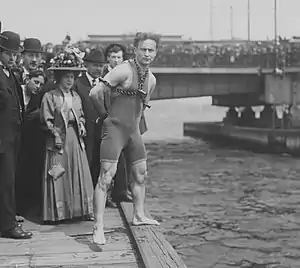
In 1898, 3-foot (0.91 m; 0.54 sm)-wide bicycle lanes were installed next to each curb.[5] In 2011 (113 years later), the City of Boston finally connected these lanes to its own bike lanes.[24]
A marker near the southeast end of the bridge memorializes one of Harry Houdini's "well known escapes", during which he jumped from the bridge on May 1, 1908. (Other sources give the date as April 30, 1908.)[25]
The bridge was declared unsafe in 1909, requiring all of the iron and steel to be replaced. The draw was elevated slightly and the trolley rails were replaced as well.[26]
When the Metropolitan District Commission (MDC) took control of the bridge in 1924, they rebuilt much of the bridge superstructure. They replaced the wooden stringers with steel "I" beams, topped wooden deck elements with concrete and brick, and replaced the street car rails.[5] Structural steel hangers replaced wrought iron. The swing span was converted into two 75-foot (23 m; 13.4 sm) fixed spans the same width as the rest of the bridge. The wooden pier was heavily modified with concrete and stone to make it resemble the other piers, increasing the number of stone piers from 23 to 24.[3][27]
Heavy traffic at the Mass Ave and Memorial Drive intersection on the Cambridge end of the bridge led to the construction of an underpass in 1931.[7]
The bridge was formerly referred to as the "Xylophone Bridge" because of the sound its wooden decking made when traffic traveled over it. This decking was replaced in 1949 with 3-inch (76 mm; 0.045 sm) concrete-filled "I-beam lok" grating topped with a 2.25-inch (57 mm; 0.0336 sm) thick bituminous wearing surface. At this time, all bearings were replaced, and the trolley car tracks were removed, as were granite blocks. The trolley car poles were reused for street lights. Ramps between the bridge and the under-construction Storrow Drive were added.[7]
The 1924 sidewalk slabs were replaced by precast, prestressed slabs in 1962.[7] The fifteen expansion dams were replaced or repaired in 1969.[28]
Engineering study, 1971–1972
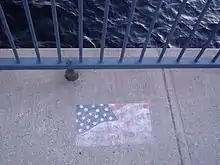
An engineering study was performed by the Metropolitan District Commission (later merged into the Department of Conservation and Recreation) in 1971–1972 due to complaints by bridge users of excessive vibration.[7][29] The bridge was found to be understrength for its load. Before the final study was complete, the recommendation was to place a load limit of 8 short tons (7.3 t) per axle and a total of 15 short tons (14 t) per vehicle, or to restrict trucks to the interior lanes, where the bridge was stronger. A 25-short-ton (23 t) limit was imposed.[30]
Suggestions made included strengthening the existing structure by adding either struts or plates to make the existing four beams along the length of the bridge into a stiffening truss, or to replace the superstructure with a new one, made of either steel or concrete, which would be up to current standards.[29] The recommendation was to replace the superstructure with one weighing approximately the same in order to reuse the piers, which were in good condition.[30]
The reasoning was that the cost of a new structure could be predicted much more easily than the cost of repairing and reinforcing the existing bridge. The resulting new bridge would be of known materials and quality, such as ductile structural steel rather than brittle wrought iron, and rated at AASHO HS-20. Repairing the existing structure would leave old wrought iron of uncertain quality and condition standing, and would not bring the design up to (then) current standards.[30] Detailed engineering calculations were included.[31] The price was estimated at US$2.5 million to US$3 million[30] (US$15,000,000 to US$18,000,000 with inflation[12]).
The action taken based on this study was to establish load restrictions on the bridge, 15 short tons (14 t) in the outer lanes, 25 short tons (23 t) on the inner lanes. This was expanded in 1979 to a flat limit of 15 short tons (14 t) on the whole bridge.[32]
Superstructure replacement, 1980s
After the failure of the Mianus River Bridge at Greenwich, Connecticut in 1983, the Harvard Bridge was shut down and inspected because it contained similar elements, specifically the suspended spans.[33][34] Traffic was restricted to the inner two lanes due to the discovery of two failed hangers on span 14. A few days later, all trucks and buses were banned from the bridge.[32]
In 1986, a report was published containing the plan to replace the superstructure on the existing supports. Alternatives considered were very similar to the 1972 report, and were similarly decided.[35] Structural modifications included an upgrade from four longitudinal girders to six of the same shape and replacement of a stairway with a handicapped pedestrian ramp on the Boston end of the bridge.[36]
Ramp "B", from southbound (Boston bound) bridge lanes to eastbound Storrow Drive, caused traffic to merge onto Storrow Drive from the left (high speed) lanes using a short acceleration lane, causing safety issues. The MDC requested elimination of this ramp. Compared to overall bridge traffic of 30,000 vehicles per day, traffic on ramp B was found to be low, approximately 1,500 vehicles per day with a peak of 120 vehicles per hour.[37]
The historic value of the bridge was considered significant, so the plan was to make the replacement superstructure appear similar, with similar railing and lighting. In order to document the pre-existing structure, a Historic American Engineering Record (HAER) would be prepared.[38]
Pier 12 was exhibiting inappropriate movement and was scheduled for reinforcement.[39]
The work would be done in two phases. Phase 1 would reinforce the downstream side of the bridge to allow MBTA bus traffic, and was expected to take 5 months. Most of this effort would be spent on the underside of the bridge and would not affect existing traffic. Phase 2 would replace the entire superstructure and was expected to take three construction seasons to implement. Cost was estimated to be US$20M [39] (US$47,000,000 with inflation[12]). Phase 1 finished in 1987, and Phase 2 in 1990.[40]
- Before-and-after images
.jpg.webp) Bridge viewed from the upstream Cambridge side in 1985. Construction barrels restricting traffic from the outside lanes, and general wear and tear are visible (click on image to enlarge)
Bridge viewed from the upstream Cambridge side in 1985. Construction barrels restricting traffic from the outside lanes, and general wear and tear are visible (click on image to enlarge)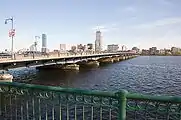 Roughly the same view, in 2009. Superstructure is in much better shape only 20 years after completion, than the 1985 superstructure was roughly 40 years after its most recent major work.
Roughly the same view, in 2009. Superstructure is in much better shape only 20 years after completion, than the 1985 superstructure was roughly 40 years after its most recent major work.
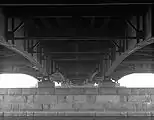 Underside of the bridge in 1985. Image shows how the bridge was originally built, and later modified, but before the superstructure was replaced.
Underside of the bridge in 1985. Image shows how the bridge was originally built, and later modified, but before the superstructure was replaced.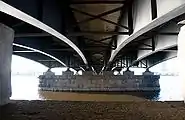 Underside of the bridge in 2009. Image shows how the replacement superstructure was built, with six longitudinal girders, different bracing, etc.
Underside of the bridge in 2009. Image shows how the replacement superstructure was built, with six longitudinal girders, different bracing, etc.
Subsequent events
In the fall of 2014, the Charles River Conservancy announced that an anonymous donor would fund an upgrade of the street lights for both the roadway and both sidewalks on the bridge.[41][42] The new roadway and aesthetic lighting was installed in 2015, highlighting the smoot marks along the sidewalk. The design was selected after a competition won by Miguel Rosales of Rosales + Partners.[43][44][45] The light posts will be located 30 smoots (167.5 ft; 51.05 m) apart.[46] "It will provide safe lighting for pedestrians and drivers, and the elements of design on the bridge will be pulled out and emphasized. It will become a really beautiful bridge," said Renata von Tscharner, founder and president of the Charles River Conservancy.[47][48]
Smoots
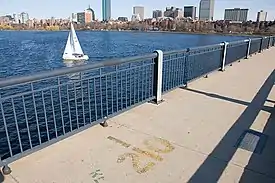
The Harvard Bridge is marked off in an idiosyncratic unit of measure, the smoot.
In 1958, members of the Lambda Chi Alpha fraternity at MIT measured the bridge's eastern sidewalk by using that year's shortest pledge, Oliver Smoot—nominally, 5 feet 7 inches (1.70 m) tall—as a measuring stick.[7][8] Years after this stunt, Smoot became president of the American National Standards Institute (ANSI), and later president of the International Organization for Standardization (ISO).[49]
Markers painted at 10-smoot (55.83 ft; 17.02 m) intervals give the bridge's length 364.4 smoots long, "plus one ear". Originally this read "plus or minus one ear"—representing measurement uncertainty[50]—but over the years the words "or minus" disappeared.[51] The marks are repainted twice each year by members of the fraternity[7][52]—originally surreptitiously and later openly.
During the major reconstruction in the 1980s, the new sidewalks were divided into smoot-length slabs rather than the standard six feet, and the smoot markings were painted on the new deck.[53] Officials' original determination to omit the smoot markings from the reconstructed bridge, and to scrupulously prevent the fraternity from repainting them, evaporated when it was realized that police routinely used the smoot marks as reference points in accident reports.[54]
The nominal length of 364.4 smoots (from two designated points at the bridge's ends) corresponds to about 2030 feet or 620 m, somewhat less than the bridge's published length of 660 meters (2,170 ft; 390 sm).[1][21] A possible cause is that in 1958, there were ramps to Storrow Drive on both sides of the bridge, which interrupted the sidewalk earlier than it extends today. A bridge of 659.82 m[1][55] corresponds to 387.7 smoots ± one ear.
See also
References
Informational notes
- The structure now called the Longfellow Bridge opened 15 years later, and was given its current name in 1927.
Citations
- Harvard Bridge at Structurae
- Department of Conservation and Recreation National Bridge Inventory (2012). "Place Name: Boston, Massachusetts; NBI Structure Number: 417208078401120; Facility Carried: Route 2A; Feature Intersected: Charles River". Nationalbridges.com (Alexander Svirsky). Retrieved March 28, 2012.
- HAER, p.4
- Alger & Matthews 1892, p. 15.
- HAER, p. 3
- Alger & Matthews 1892, p. 14.
- HAER, p. 5
- "This Month in MIT History, "The Tech", volume 119, number 49". Tech.mit.edu. Retrieved October 17, 2014.
- Alger & Matthews 1892, p. 5.
- Alger & Matthews 1892, pp. 5-6.
- Alger & Matthews 1892, p. 9.
- Federal Reserve Bank of Minneapolis. "Consumer Price Index (estimate) 1800–". Retrieved January 1, 2020.
- Alger & Matthews 1892, pp. 10-12.
- Alger & Matthews 1892, p. 13.
- Alger & Matthews 1892, p. 31.
- Alger & Matthews 1892, p. 30.
- "Recent Deaths". Boston Evening Transcript. Boston, Massachusetts: Boston Transcript Company. February 16, 1891. p. 2. Retrieved April 17, 2012.
Mr. Leander Greeley, a prominent master builder of Boston and Cambridge and one of the three Harvard Bridge Commissioners, died this morning. Mr. Greeley, who in health was a man of fine physique, had of late been subject to ailments for which he had sought Florida as a relief. He was an enterprising and public-spirited citizen of Cambridge, where he had often been called by the public to positions of trust. He was also a working member of several benevolent orders. There are many monuments of his skill as a builder in and about Boston, including many churches. The Master Builders' Association will sincerely mourn his loss. He was about sixty years old and leaves a family.
- Alger & Matthews 1892, pp. 13-14.
- Alger & Matthews 1892, p. 32.
- Alger & Matthews 1892, pp. 18-26.
- Alger & Matthews 1892, p. 17.
- Alger & Matthews 1892, p. 18.
- Alger & Matthews 1892, p. 29.
- Kaiser, Johanna (January 6, 2012). "Mass. Ave, BU Bridge bike lanes completed". Boston Globe. New York Times Co. Retrieved March 20, 2012.
The city installed bike lanes on the northbound and southbound lanes between Huntington Avenue and the Harvard Bridge, connecting them to existing bike lanes, just before the start of the new year.
- Clinger, Julia (June 1, 2007). It Happened in Boston. It Happened In (1st ed.). TwoDot. pp. 61–63. ISBN 978-0-7627-4134-2.
- "Famous Harvard Bridge Unsafe" (PDF). New York Times. July 16, 1909. Retrieved March 20, 2012.
The famous Harvard Bridge connecting Cambridge and Boston was declared to be unsafe in a report made to-day by a commission of Boston and Cambridge engineers, and announcement was made that work would be started on Monday next to strengthen the structure. The commission finds that all of the iron and steel beams of the bridge, which is nearly three-quarters of a mile long, will have to be replaced by new ones, at the same time the draw will be elevated slightly, and new surfacing will be put on. The Boston elevated railway company, which operates its cars across the bridge, is ordered to install new rails and new supports.
- "Commonwealth Begins Work on Harvard Bridge" (PDF). The Tech. Cambridge, Massachusetts: Massachusetts Institute of Technology. October 3, 1924. p. 5, col. 4. Retrieved April 27, 2009.
- HAER, p.6
- Leet, phase 2
- Leet, phase 3
- Leet, phase 3, appendices
- HAER, p.8
- Keane, Tom (September 10, 2006). "It's the Engineering, Stupid". Boston Globe Magazine. Boston Globe. Retrieved September 11, 2006.
- "AROUND THE NATION; Boston's Harvard Bridge Closed to Heavy Trucks". The New York Times. United Press International. July 6, 1983. Retrieved April 13, 2009.
- Replacement, p.7
- Replacement, p.4
- Replacement, page 4-6
- Replacement, p.11. Note the use of the HAER document throughout this article.
- Replacement, page 5
- Ronald Rosenberg, Globe Staff (September 12, 1990). "MASS. AVE. BRIDGE TO REOPEN FOUR LANES AFTER SEVEN YEARS". Boston Globe. Boston, Massachusetts. p. 35 (METRO section).
- "Smoot lighting: $2.5 million gift will brighten Mass. Ave. bridge - Metro - The Boston Globe". BostonGlobe.com. Retrieved October 17, 2014.
- "$2.5 million gift will shed light on the Harvard Bridge". Thecharles.org. Retrieved October 17, 2014.
- "Archived copy". Archived from the original on November 29, 2014. Retrieved November 21, 2014.CS1 maint: archived copy as title (link)
- Ramos, Nestor (October 14, 2014). "$2.5 million gift will shed light on the Harvard Bridge". Boston Globe. Boston Globe. Retrieved October 22, 2014.
- "With Smoot design, Harvard Bridge is the latest to shine". Boston Globe. Boston Globe. October 21, 2014. Retrieved October 22, 2014.
- "Smoot legacy continues on Harvard Bridge - The Tech". Tech.mit.edu. Retrieved November 20, 2014.
- "An Anonymous Donor Is Bringing Light to the Mass. Ave. Bridge". Bostonmagazine.com. September 2, 2014. Retrieved October 17, 2014.
- "An Anonymous Donor is Bringing Light to the Mass. Ave. Bridge". Thecharles.org. Retrieved October 17, 2014.
- "Oliver R. Smoot". American National Standards Institute (ANSI). Retrieved January 10, 2014.
- Tavernor, Robert, Smoot's Ear: the Measure of Humanity (Yale University Press, 2007; paperback edition 2008), ISBN 978-0-300-12492-7, Preface
- "Smoot in Stone". MIT News. Cambridge, Massachusetts: Massachusetts Institute of Technology. June 4, 2009. Retrieved July 20, 2010.
Specifically noting the bridge's length of 364.4 Smoots (+/- 1 ear), the plaque, a gift of the MIT Class of 1962, honors the prank's 50th anniversary.
- "MIT Tech Review article". Alumweb.mit.edu. Retrieved October 17, 2014.
- Fahrenthold, David A. (December 8, 2005). "The Measure of This Man Is in the Smoot". The Washington Post. Washington DC. Retrieved April 20, 2009.
And then there was a little help from the government: When the bridge was renovated about 15 years ago, officials agreed to let the markings stay, even going so far as to score the sidewalk at 5-foot-7 Smoot intervals instead of the usual six-foot ones.
- Brehm, Denise (September 1, 1999). "Keyser describes his top five hacks - MIT News Office". MIT News. Cambridge, Massachusetts: Massachusetts Institute of Technology. Retrieved March 4, 2012.
When the bridge was rebuilt in the 1980s, the Cambridge police requested that the smoots remain because they use them to indicate precise locations in accident reports.
- Alger and Matthews, p. 17
Bibliography
- (Nationalbridges.com): Department of Conservation and Recreation National Bridge Inventory (2012). "Place Name: Boston, Massachusetts; NBI Structure Number: 417208078401120; Facility Carried: Route 2A; Feature Intersected: Charles River". Nationalbridges.com (Alexander Svirsky). Retrieved March 28, 2012. Note: this is a formatted scrape of the 2009 official website, which can be found here for Massachusetts: "MA09.txt". Federal Highway Administration. 2009. Retrieved August 27, 2009.
- Alger, Alpheus B.; Matthews, Nathan Jr. (1892), Harvard Bridge: Boston to Cambridge, March 1892, Boston, Massachusetts: Rockwell and Churchill, retrieved April 10, 2009
- Historic American Engineering Record (HAER) No. MA-53, "Harvard Bridge, Spanning Charles River at Massachusetts Avenue, Boston, Suffolk County, MA", 58 photos, 62 data pages, 4 photo caption pages
- (Replacement): United States Department of Transportation, Massachusetts Department of Public Works (October 27, 1986). Harvard Bridge/Massachusetts Avenue Bridge over the Charles River, Bridge replacement project, Environmental Assessment. Washington, D.C.: The Administration. LCC TG24.M4 H376 1986. Submitted pursuant to 42 U.S.C. 4332 (2) (c), and 23 U.S.C. 128 (a).
- Leet, Kenneth M., PhD (July 7, 1972). The Harvard Bridge, phase 2 report. Boston, Massachusetts: Metropolitan District Commission. LCC TG24.M4 H374 Ph.2.
- Leet, Kenneth M., PhD (October 1972). The Harvard Bridge, final report phase 3. Boston, Massachusetts: Metropolitan District Commission. p. 1. LCC TG24.M4 H374 Ph.3.
External links
| Wikimedia Commons has media related to Harvard Bridge. |
